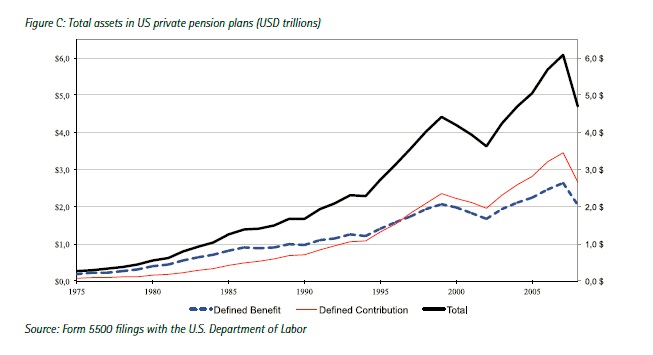A new report begins with the now-familiar distinction between defined contribution and defined benefit plans, but rings some relatively novel changes on it. The EDHEC-Risk study, “Shifting Toward Hybrid Pension Systems,” supported also by AXA Investment Managers, begins in concern that pension funds “do not fully use their ability to diversify across asset types such as illiquid assets,” and that they face at least two key sorts of risk requiring a long time horizon. There is the risk of continued inflation, eating into the value of any defined benefits, or any savings. This risk must somehow be shared among generations. Related but distinct, there is the concern that people are outliving actuarial expectations.
Unfortunately, as a consequence of short-term biases, some pension funds can be locked into less-than-optimal strategies and minimum funding ratios.
DB funds, the traditional arrangements in which an employee’s pension rights are independent of the value of the assets in the fund, are a declining part of the retirement picture in many countries. In the U.S. in particular, the assets under management by DC plans (those where the liabilities equal the fund’s market value) passed the AUM under DB plans in the late 1990s, and the difference has widened steadily through both booms and busts since.
The phrase “hybrid pension system,” as you might expect, refers to systems that can be categorized neither as DC nor as DB simply. This may involve for example risk sharing amongst employees, within or between generations of recipients, in the context of a collective defined contribution (CDC). The essential argument of this study, by Samuel Sender, Applied Research Manager at EDHEC, is that demographics will push DC plans to become hybrid.
DBs Still Have a Place
Further, the remaining DB plans, which “still have a place in the provision of retirement,” will also have to become hybrids. They “must be insured against the risk of default of their sponsor, and mortality [the possibility that beneficiaries will live longer than calculations account for] should be hedged.” The risk of unexpected longevity, then, “could be partly shared with employees (who in theory would need to work longer).”
In the U.S., one existing form of hybrid is the so-called “cash-balance plan.” Sender says in a note that these plans “are usually DB plans from the sponsor’s perspective” because they involve an interest rate credit independent of the financial returns of the plans, tied to an external index, perhaps for inflation or long-term bonds. This is “not central” to Sender’s study. The continent of Europe is well ahead of both the US and the UK in the development of the sorts of hybrid that are central.
The Netherlands, in particular, comes in for praise as the home of a more “professionally organised pension fund industry” than any other country, with nearly universal coverage. Ninety-four percent of the population of the country is covered by a hybrid pension plan, usually a plan organized on an industry-wide basis, an arrangement Sender recommends due to the economies of scale involved.
Inflation Risks
For those who rely upon DC funds, a common situation now in both the UK and the US, for the bulk of their retirement income, inflation indexation or other hedges are of course crucial. The obvious way to build inflation protection into a DC system is to make the purchase of inflation-linked bonds the default option: the option a worker ‘chooses’ by not making any other choice.
Unfortunately, Sender says, this is unrealistic. There is an inadequate supply of the necessary inflation-linked securities: “OECD inflation-linked bonds represent a mere 4% of OECD pension liabilities.” There is a necessary trade-off between “nominal guarantees and indexation ambitions.”
The Dutch plans that he admires are “generally of hybrid DBs, with nominal guarantees plus indexation [for inflation] conditional to the funding ratio being higher than the prudential requirement.”
DC plans can nonetheless adapt to the worries about inflation that their worker participants have, by more “tailored solutions” that will involve the availability of inflation linked instruments as part of a preferred option, and transparency about both the costs and the benefits of these.
Meanwhile, the managers of pension plans (DBs) are mainly bound as a matter of law by the prudent man rule, not subject to the more quantitative restrictions that apply to retail funds or insurance companies. Thus, pension managers can chose to devote some of their portfolio to hedge funds, private equity, or other potentially illiquid strategies. Sender believes “that the ideal retirement vehicle, even if it is of a fund type (possibly in DC plans) should have the same investment freedom as pension funds.”
- English (UK)
- English (India)
- English (Canada)
- English (Australia)
- English (South Africa)
- English (Philippines)
- English (Nigeria)
- Deutsch
- Español (España)
- Español (México)
- Français
- Italiano
- Nederlands
- Português (Portugal)
- Polski
- Português (Brasil)
- Русский
- Türkçe
- العربية
- Ελληνικά
- Svenska
- Suomi
- עברית
- 日本語
- 한국어
- 简体中文
- 繁體中文
- Bahasa Indonesia
- Bahasa Melayu
- ไทย
- Tiếng Việt
- हिंदी
Pensions, Inflation And Longevity Risk
Published 05/16/2012, 03:27 AM
Updated 07/09/2023, 06:31 AM
Pensions, Inflation And Longevity Risk
3rd party Ad. Not an offer or recommendation by Investing.com. See disclosure here or
remove ads
.
Latest comments
Install Our App
Risk Disclosure: Trading in financial instruments and/or cryptocurrencies involves high risks including the risk of losing some, or all, of your investment amount, and may not be suitable for all investors. Prices of cryptocurrencies are extremely volatile and may be affected by external factors such as financial, regulatory or political events. Trading on margin increases the financial risks.
Before deciding to trade in financial instrument or cryptocurrencies you should be fully informed of the risks and costs associated with trading the financial markets, carefully consider your investment objectives, level of experience, and risk appetite, and seek professional advice where needed.
Fusion Media would like to remind you that the data contained in this website is not necessarily real-time nor accurate. The data and prices on the website are not necessarily provided by any market or exchange, but may be provided by market makers, and so prices may not be accurate and may differ from the actual price at any given market, meaning prices are indicative and not appropriate for trading purposes. Fusion Media and any provider of the data contained in this website will not accept liability for any loss or damage as a result of your trading, or your reliance on the information contained within this website.
It is prohibited to use, store, reproduce, display, modify, transmit or distribute the data contained in this website without the explicit prior written permission of Fusion Media and/or the data provider. All intellectual property rights are reserved by the providers and/or the exchange providing the data contained in this website.
Fusion Media may be compensated by the advertisers that appear on the website, based on your interaction with the advertisements or advertisers.
Before deciding to trade in financial instrument or cryptocurrencies you should be fully informed of the risks and costs associated with trading the financial markets, carefully consider your investment objectives, level of experience, and risk appetite, and seek professional advice where needed.
Fusion Media would like to remind you that the data contained in this website is not necessarily real-time nor accurate. The data and prices on the website are not necessarily provided by any market or exchange, but may be provided by market makers, and so prices may not be accurate and may differ from the actual price at any given market, meaning prices are indicative and not appropriate for trading purposes. Fusion Media and any provider of the data contained in this website will not accept liability for any loss or damage as a result of your trading, or your reliance on the information contained within this website.
It is prohibited to use, store, reproduce, display, modify, transmit or distribute the data contained in this website without the explicit prior written permission of Fusion Media and/or the data provider. All intellectual property rights are reserved by the providers and/or the exchange providing the data contained in this website.
Fusion Media may be compensated by the advertisers that appear on the website, based on your interaction with the advertisements or advertisers.
© 2007-2024 - Fusion Media Limited. All Rights Reserved.
